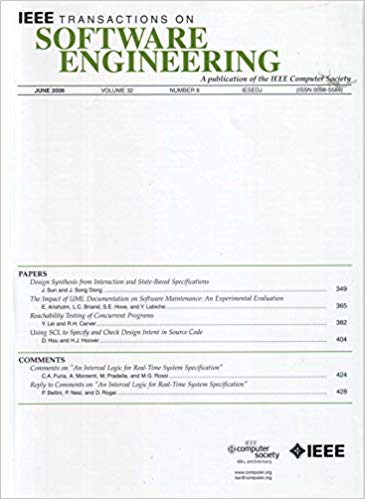法学硕士在代码生成与总结中的有效性研究
IF 5.6
1区 计算机科学
Q1 COMPUTER SCIENCE, SOFTWARE ENGINEERING
引用次数: 0
摘要
大型语言模型(llm)最近被用作复杂自然语言处理任务的裁判,例如问答(Question & Answer)。其基本思想是委托LLM对自动化技术(通常是另一个LLM)提供的输出的“质量”进行评估,以完成以下任务:(i)定量指标只能说明部分情况,并且;大规模的以人为基础的评价过于昂贵。法学硕士作为法官,如果被证明对特定任务有效,也可以开启自动化的新可能性,几个法学硕士为任务的给定实例(例如,问题的答案)提出解决方案,其他法学硕士判断并决定向用户展示的最佳输出。我们研究了llms作为法官在两个与代码相关的任务,即代码生成和代码总结中的有效性。选择这些任务的理由有两个方面。首先,定量度量通常不足以评估代码汇总器/生成器。例如,对于生成的摘要的质量来说,BLEU之类的度量是非常弱的代理。其次,即使是最先进的技术仍然难以处理这些任务的复杂实例(例如,总结一个相当长/复杂的函数),这使得它们成为从更先进的解决方案中受益的好候选人,这些解决方案设想了llm之间的协作。对于代码生成,我们检查了8个llm是否能够判断由同一llm生成或由人类实现的1,405个Java方法和1,281个Python函数的正确性。对于代码总结,我们将5个llm的判断与9个人提供的关于Java和Python函数的$\sim$ 1.2k摘要的判断进行比较。我们的研究结果表明,就这两项任务的判断能力而言,GPT-4-turbo是最好的LLM,而具有数百亿参数的“较小”LLM无法应对判断任务。然而,即使是性能最好的LLM也经常错误地判断代码的正确性和摘要的质量。本文章由计算机程序翻译,如有差异,请以英文原文为准。
On the Effectiveness of LLM-as-a-Judge for Code Generation and Summarization
Large Language Models (LLMs) have been recently exploited as judges for complex natural language processing tasks, such as Q&A (Question & Answer). The basic idea is to delegate to an LLM the assessment of the “quality” of the output provided by an automated technique (often another LLM) for tasks for which: (i) quantitative metrics would only tell part of the story, and; (ii) a large-scale human-based evaluation would be too expensive. LLMs-as-a-judge, if proven effective for a specific task, can also unlock new possibilities for automation, with several LLMs proposing a solution for a given instance of the task (e.g., an answer to a question) and others judging and deciding what is the best output to show the user. We study the effectiveness of LLMs-as-a-judge for two code-related tasks, namely code generation and code summarization. The rationale for choosing these tasks is two-fold. First, quantitative metrics are usually not enough for the assessment of code summarizers/generators. For example, it is well documented that metrics such as BLEU are quite weak proxies for the quality of the generated summaries. Second, even state-of-the-art techniques still struggle with handling complex instances of these tasks (e.g., summarizing a quite long / complex function), making them good candidates for benefiting from more advanced solutions envisioning collaboration among LLMs. For code generation, we check whether eight LLMs are able to judge the correctness of 1,405 Java methods and 1,281 Python functions generated by the same LLMs or implemented by humans. For code summarization, we compare the judgment of five LLMs to those provided by ninehumans for $\sim$
求助全文
通过发布文献求助,成功后即可免费获取论文全文。
去求助
来源期刊

IEEE Transactions on Software Engineering
工程技术-工程:电子与电气
CiteScore
9.70
自引率
10.80%
发文量
724
审稿时长
6 months
期刊介绍:
IEEE Transactions on Software Engineering seeks contributions comprising well-defined theoretical results and empirical studies with potential impacts on software construction, analysis, or management. The scope of this Transactions extends from fundamental mechanisms to the development of principles and their application in specific environments. Specific topic areas include:
a) Development and maintenance methods and models: Techniques and principles for specifying, designing, and implementing software systems, encompassing notations and process models.
b) Assessment methods: Software tests, validation, reliability models, test and diagnosis procedures, software redundancy, design for error control, and measurements and evaluation of process and product aspects.
c) Software project management: Productivity factors, cost models, schedule and organizational issues, and standards.
d) Tools and environments: Specific tools, integrated tool environments, associated architectures, databases, and parallel and distributed processing issues.
e) System issues: Hardware-software trade-offs.
f) State-of-the-art surveys: Syntheses and comprehensive reviews of the historical development within specific areas of interest.
 求助内容:
求助内容: 应助结果提醒方式:
应助结果提醒方式:


